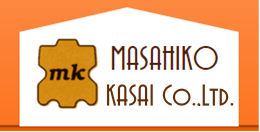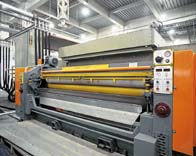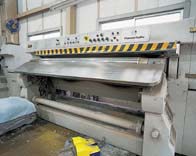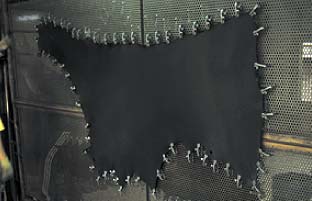








| Leather-Tanning Process |
|||||||
| Raw skins | Soaking | Unhairing and liming | Fleshing | ||||
Separation into thick, large, heavy skins and hides that weigh more than 25 pounds (cowhide leather, etc.)、and small, light skins such as calf leather |
Impurities adhering to the leather are removed, the dehydrated moisture is collected, and it is returned to rawhide condition. This process is important to ensure that the subsequent chemical treatment is carried out smoothly. |
The skin is immersed in lime milk, it is swollen with alkali, and the collagen fibres of the skin are loosened; at the same time, hair, fat and skin layers are removed by decomposition. |
 A fleshing machine is used to remove impurities adhering to the flesh surface (back) of the leather. |
||||
| Band knife | Pickling | Chrome tanning | Slitting | ||||
 A splitting machine (splitting, band knife) is used to split the silver surface (surface) and the flesh surface (split) sides into two |
Any lime left in the skin due to unhairing or liming, etc. is removed, softening the skin and ensuring easy penetration of liniment |
|
Chrome tanning permeates the skin and bonds with the collagen fibres, leading to antiseptic durability factors such as heat resistance, etc. |
Cutting the leather in half at the back |
|
||
| W/B | Sammying | Shaving (Back-cutting) | Raw skin inspection | ||||
Raw skin became leather, so can be stored |
 |
Shaving back skins by the machine and keeping constant thickness |
|||||
| Trimming | Neutralization, dyeing, greasin | Sammying/stretching | Drying | ||||
The unusable part of the tip of the leather is cut |
|
The acid in the leather is neutralized, adjustments are made so that the penetration of the dye and the greasing agent are uniform, and the leather is dyed to the desired color using a water-soluble dye or the like. A greasing agent is used to impart characteristics of texture such as flexibility. |
|
A sammying/setting machine is used to squeeze extra moisture out of the leather, and to stretch the leather. |
The moisture is removed by drying the leather, either naturally or with hot air. By drying, the dyes and the greasing agents in the leather will adhere. |
||
| Inspection of drying | Staking | Toggle drying | Substrate inspection | ||||
The moisture content of the leather is measured with an Acqua Piccolo (water content meter). |
A staking machine is used to stake the leather, giving it softness and elasticity |
 The leather is stretched on a net to dry. The moisture content is stable across the entirety of the leather. |
The thickness, softness, loose grain, etc. of the substrate is checked prior to finishing. |
||||
| Trimming | Roll coater/spray | Chemical formulation | |||||
Unnecessary parts of the leather end cap are cut. |
|
Methods of painting leather include painting with a roll coater and using a spray machine. |
|
Color adjustments are made |
|||
| Embossing | Milling | Color inspection | Product inspection | ||||
| The leather is pushed into a mold |
|
The leather is softened and the surface is texturized. |
|
Color preparations |
We also carry out thorough inspections before shipping, in order to provide leather that will satisfy our customers. |
||
| Leather product | Packing | Packaging & Shipping | |||||
We measure the area of the leather. The units of area are deci (for domestic use) and square feet, etc. for foreign export |
The product is packed neatly to prevent wrinkles. |
|
|
||||